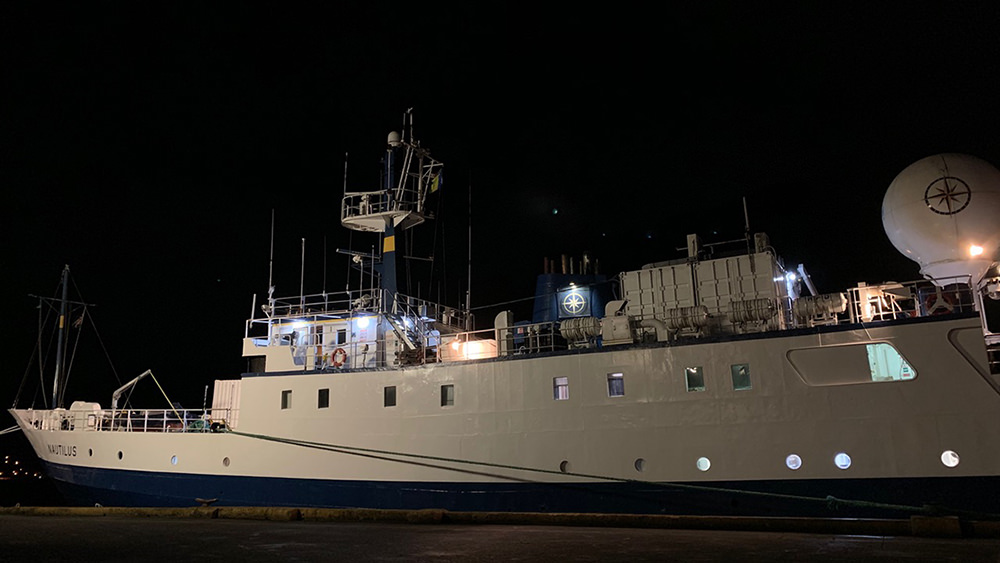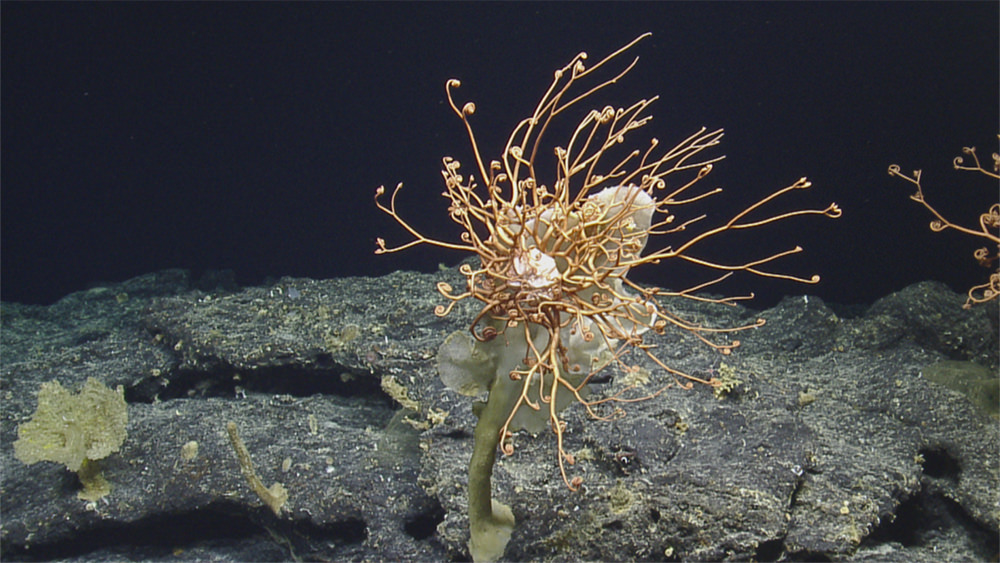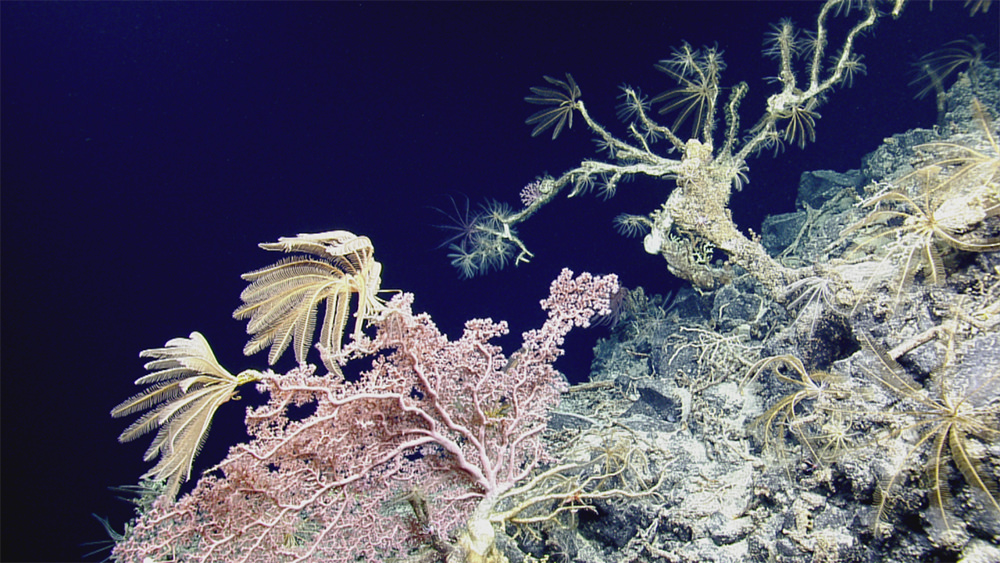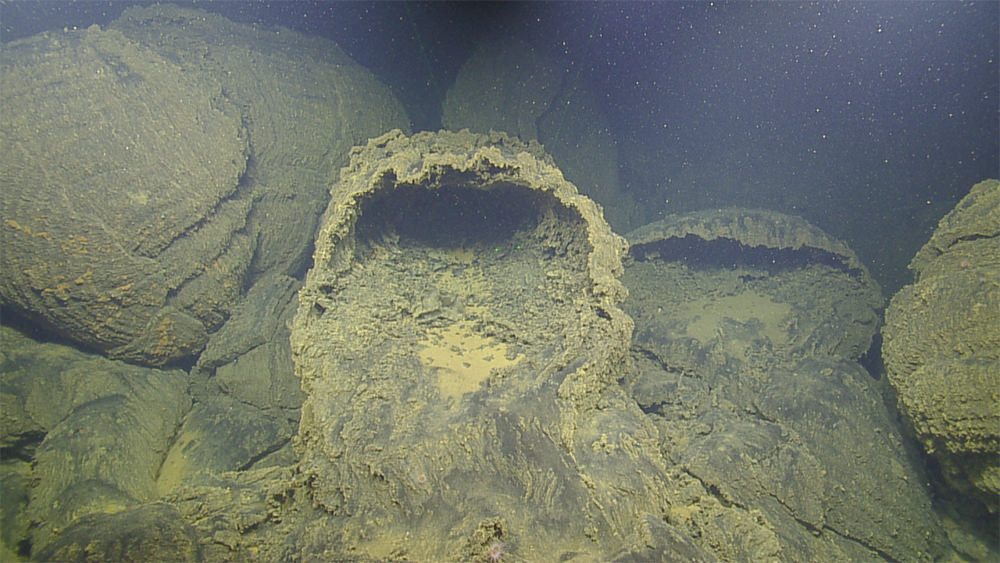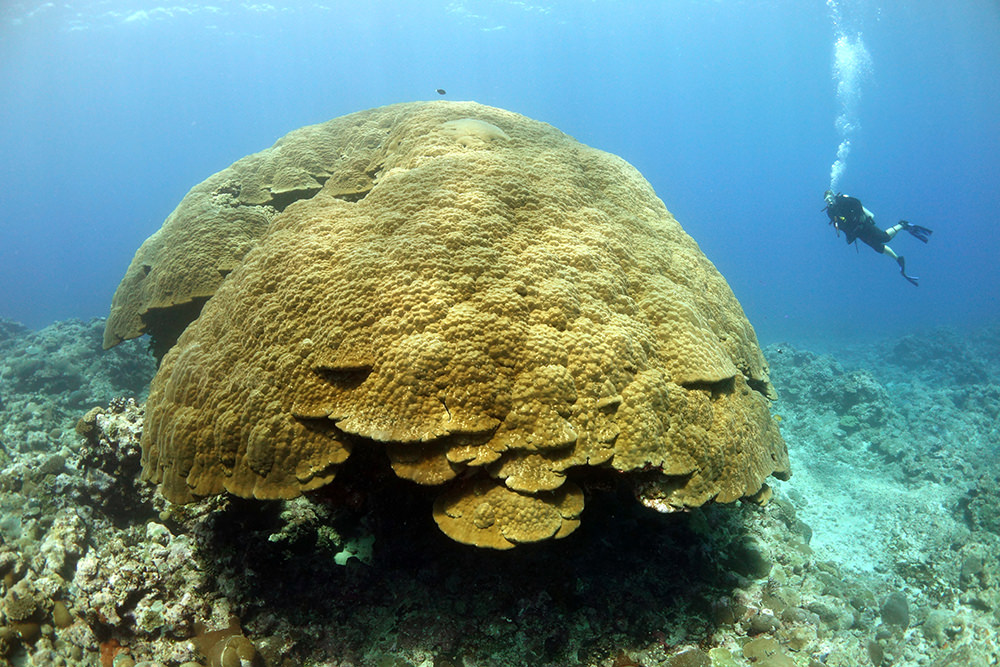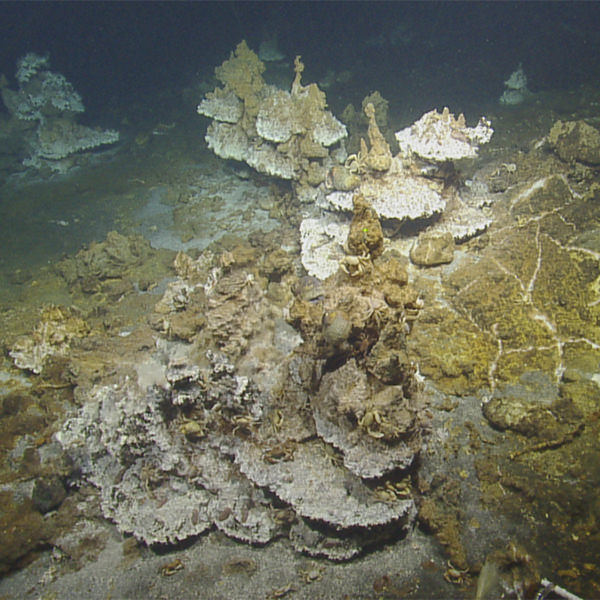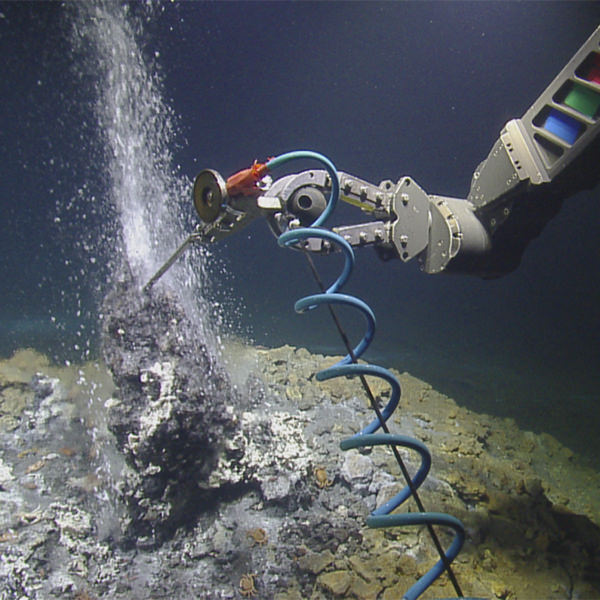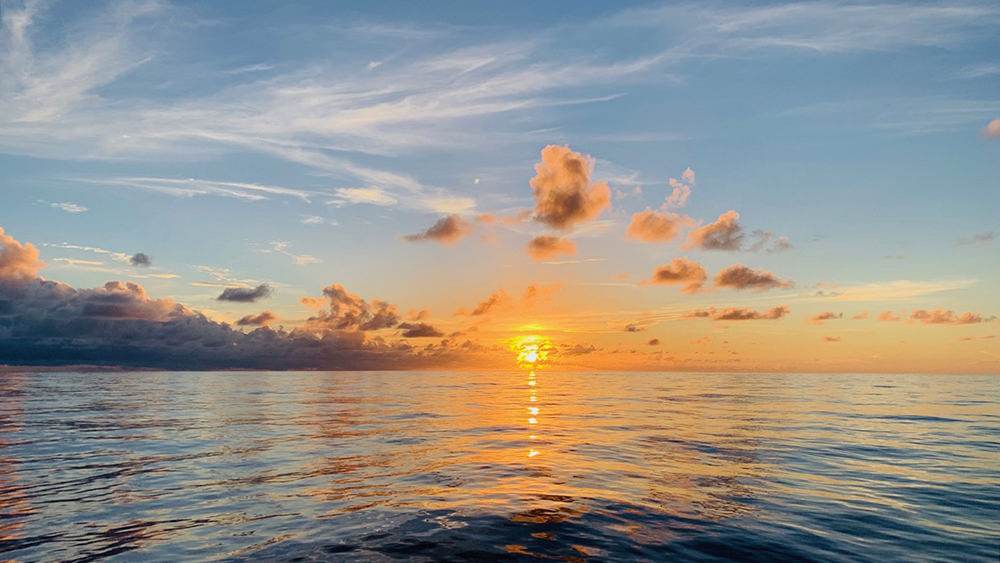Better than sci-fi!
Real-time seafloor exploration in National Marine Sanctuary of American Samoa
By Valeria Tamayo-Canadas
September 2019
Would you be ok living your life at 5 percent? Or knowing only 5 percent of the person you love? I know it sounds odd, but that is what we humans know of the place where life originated on Earth: the ocean. It is estimated that 95 percent of it is unexplored. Luckily, there are a few exploration vessels trying to change that percentage.
Among those vessels is E/V Nautilus, which I joined on its first expedition to National Marine Sanctuary of American Samoa as a science communication fellow. Building from NOAA Ship Okeanos Explorer’s 2017 map of the area, Nautilus’ expedition objectives were to expand that map and collect geological and biological samples to better understand the habitats here. Basic survey data help sanctuary staff better protect the biological and physical treasures under those waters.
My role as a science communication fellow was to bridge the experience on board and that of our viewers all over the world while we explore. In the past, I’ve worked for the Galapagos National Park and Marine Reserve in Ecuador, developed materials for Koon Marine Protected Areas in Indonesia, and developed a bioeconomic model to measure the consequences of delaying marine management actions in the Midriff Islands, Mexico. There is something about marine protected areas that has grown strong in my heart. When I saw Nautilus in Pago Pago, the capital of American Samoa, ready for us to explore the marine sanctuary, I got goosebumps.
Why explore?
Exploration is at the core of human nature. When we are kids, curiosity drives us to explore and discover the world. That same curiosity drives those of us on Nautilus to explore the ocean's depths with state-of-the-art robotic and scientific technology. Plus, the Nautilus Exploration Program is broadcast to anyone ready to join the adventure. Our followers are able to experience this “sci-fi-like” experience through nautiluslive.org. It’s better than sci-fi: it’s real science in real time.
Fifteen days to explore may seem like a lot, but the truth is National Marine Sanctuary of American Samoa is the largest sanctuary in U.S. waters. We planned on diving in the waters surrounding Tutuila, Ofu, Olosega, and Ta’u islands, as well as the Vailulu'u Seamount. We jumped to the adventure using two connected remotely operated vehicles (ROVs). Argus, the heavy silver stainless steel one, reminds me of a parent taking his kid to discover the wild. Argus is stable and absorbs most of the motion of the waves, which allows the curious kid, Hercules, to explore the deep ocean, beaming footage up for viewers to experience back on land.
Seeing the deep sea
This expedition was the first time I have seen vehicles launched for exploration. As the launch begins, viewed from the control van, the monitors and camera screens around me are blue. As the vehicles bounce in surface waves, lots of bubbles appear then race off the lenses as the ROVs descend. The blue intensifies, getting darker as the cameras and ROVs sink deeper.
Long before we reach the seafloor at 9,842 feet (3,000 meters), all is dark. No sunlight reaches this unknown place. We can see only what Hercules' lights allow us to glimpse. After a couple of minutes at the seafloor, we get the first image: thin deep-sea corals moving slowly in the current.
Though shallow-water coral reefs are well studied, we still know little about their deep-sea relatives. It is difficult and costly to observe them and sample them, and therefore hard to understand their behavior and ecology. Unlike shallow-water corals, deep-sea corals live in places where there is no sunlight, so they feed primarily by catching detritus in the water column.
The biodiversity of the slopes of Tutuila was stunning! White sponges were scattered on the seafloor. These filter feeders sift water as it passes by for food, building skeletons with magnificent geometry. Other interesting inhabitants of the area were the crinoids, plant-looking animals that swim and crown the rocks, sponges, and corals. To my surprise, within the beams of ROV lights we saw sea cucumbers pushing themselves off the sediment, swimming up into the water column. I had no idea they could do that; I thought they only stayed at the bottom.
The rocky basalt seafloor in this area was created by volcanic eruption, once oozing as lava, likely to have originated in the Samoan hot spot. Observing the toothpaste-globs and rounded pillows, you can easily imagine how these rocks erupted and tumbled short distances before cooling in the cold water, leaving the trace of their movement paused in time.
Local wonders
Expeditions on the ocean floor are subject to the conditions on the ocean surface. When winds prevented us from exploring the deep blue, we took time to read and learn more about the ecosystems closer to the ocean surface. Local scientists onboard shared their experiences with us. They talked about the biggest registered coral colony in the world! Fale Bommie (Big Momma), a huge colony 138 feet in circumference and 23 feet tall, grows in the sunlit shallows near Ta`u Island.
Local scientists bring unique perspectives to our team and it’s inspirational to hear their stories. They taught us some words in Samoan and shared with us some of the local conservation challenges such as coral bleaching and pollution. I have worked on marine protected areas for some years, and never get tired of learning more about the wonders of the ocean and the possibilities humans have to take good care of them. Marine protected areas like National Marine Sanctuary of American Samoa help others discover their love of the ocean.
An undersea volcano
A few days later, the ship approaches Vailulu‘u, the only active seamount located in National Marine Sanctuary of American Samoa.
When dive time comes, the team is in the control van, looking at monitors while the ROVs descend and we can all feel each other’s anticipation. Once we get to the bottom we are all amazed at the rock formations. They look like stairs of an ancient structure, covered with a mustard color dust-like sediment. Experiencing a surprising landscape underwater is delightful for first-time explorers and those with decades of experience. Watch leader Dr. Robert Ballard calls out, "I have never seen something like this before!" Our viewers are as excited as we are. Questions pour across our computer screens and viewers participate in the control van conversation as team members answer their curious inquiries.
The team directs the ROV pilot to fly Hercules across the seafloor as we take in several hours of rock pillars, eels, crabs, and more. We seem to be in an alien world. White stripes left by what our team hypothesizes were sulfide-eating bacteria crisscross the seafloor.
Suddenly Renny, one of the navigators, alerts us about a strange signal on the sonar screen. After a quick discussion the pilots approach the signal, and before our eyes, towers of gas bubbles rise from the seafloor. The Hercules pilot flies our cameras in close as everyone in the control van leans forward. The science team quickly decides to take samples of the plume. Samples will be sent to research repositories across the United States for further analysis and made available to researchers around the world for future study.
Ocean for life
I cannot write about every detail of this exploration, but I want to share a little seed with you. I hope the call for exploration, care, and love for the ocean grows stronger in you and that you inspire others. The ocean is our planet's weather regulator. It feeds almost half of the world population who rely on fish as their main source of protein. Tiny plants floating on the waves create the oxygen in every other breath you take. The ocean is life and our lives depend on it.
National marine sanctuaries are more than a fancy name on a map. They are a public recognition of the value the ocean has for us, not only for the services a healthy ocean provides to humans, but for the beauty of life and inspiration that comes from it.
Valeria Tamayo-Canadas is a recent graduate of University of California, Santa Barbara, and was a Nautilus science communication fellow this summer.


